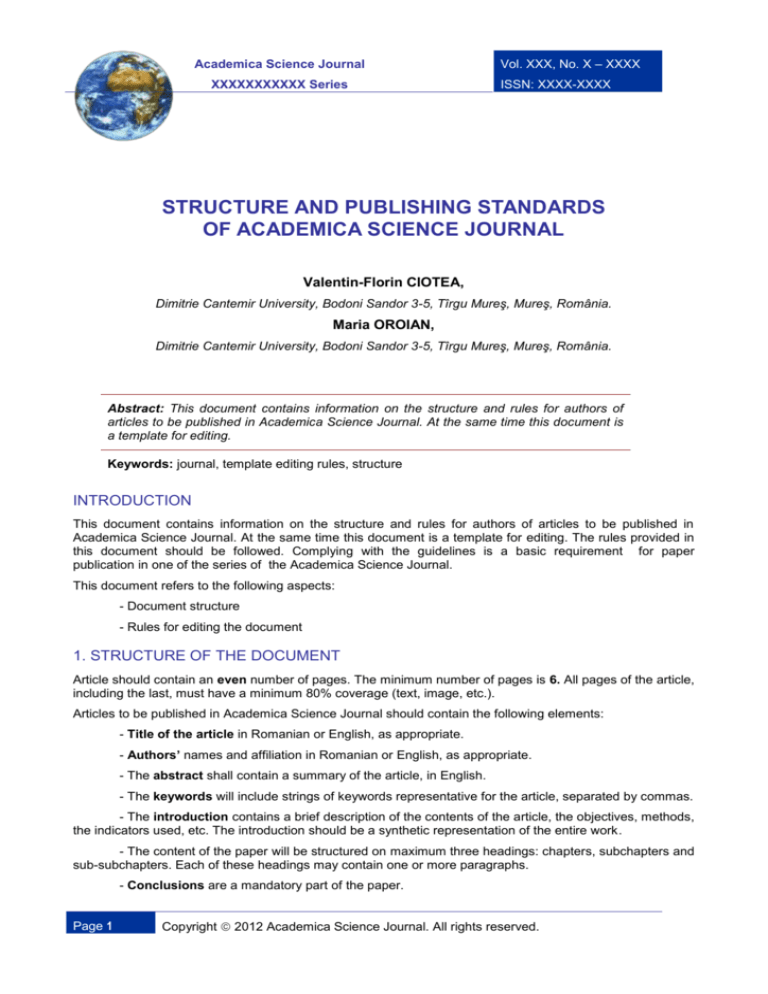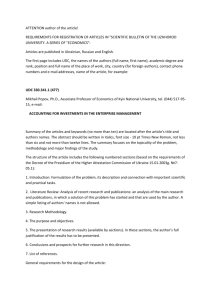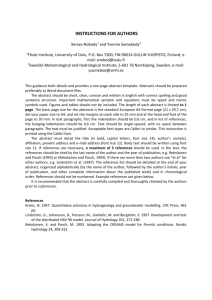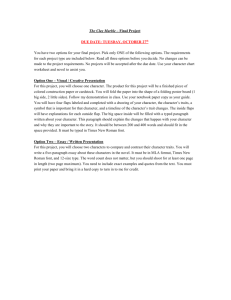
Academica Science Journal
XXXXXXXXXXX Series
Vol. XXX, No. X – XXXX
ISSN: XXXX-XXXX
STRUCTURE AND PUBLISHING STANDARDS
OF ACADEMICA SCIENCE JOURNAL
Valentin-Florin CIOTEA,
Dimitrie Cantemir University, Bodoni Sandor 3-5, Tîrgu Mureş, Mureş, România.
Maria OROIAN,
Dimitrie Cantemir University, Bodoni Sandor 3-5, Tîrgu Mureş, Mureş, România.
Abstract: This document contains information on the structure and rules for authors of
articles to be published in Academica Science Journal. At the same time this document is
a template for editing.
Keywords: journal, template editing rules, structure
INTRODUCTION
This document contains information on the structure and rules for authors of articles to be published in
Academica Science Journal. At the same time this document is a template for editing. The rules provided in
this document should be followed. Complying with the guidelines is a basic requirement for paper
publication in one of the series of the Academica Science Journal.
This document refers to the following aspects:
- Document structure
- Rules for editing the document
1. STRUCTURE OF THE DOCUMENT
Article should contain an even number of pages. The minimum number of pages is 6. All pages of the article,
including the last, must have a minimum 80% coverage (text, image, etc.).
Articles to be published in Academica Science Journal should contain the following elements:
- Title of the article in Romanian or English, as appropriate.
- Authors’ names and affiliation in Romanian or English, as appropriate.
- The abstract shall contain a summary of the article, in English.
- The keywords will include strings of keywords representative for the article, separated by commas.
- The introduction contains a brief description of the contents of the article, the objectives, methods,
the indicators used, etc. The introduction should be a synthetic representation of the entire work.
- The content of the paper will be structured on maximum three headings: chapters, subchapters and
sub-subchapters. Each of these headings may contain one or more paragraphs.
- Conclusions are a mandatory part of the paper.
Page 1
Copyright 2012 Academica Science Journal. All rights reserved.
Academica Science Journal
XXXXXXXXXXX Series
Vol. XXX, No. X – XXXX
ISSN: XXXX-XXXX
- Authors' biodata follows the conclusions and includes, in addition to the authors’ names and
organizational affiliation, the academic title, position, fields of interest or other issues related to the author.
There should be no more than a paragraph for each author.
- The references conclude the paper. They contain, in alphabetical order of the first author’s name
and year of publication, all bibliographic references in the document. References must be used wherever
there are citations, ideas, figures, photographs, tables, formulas or other content elements taken from other
bibliographic sources.
2. PUBLISHING RULES OF THE DOCUMENT
The rules for editing the document briefly describe the characteristics of form elements of the document
content.
2.1. PAGE
Pages in the document will have the following structure:
- A4;
- Margins: top - 2,5 m; down, left, right - 2 cm;
- Orientation: portrait.
2.2. TITLE OF THE DOCUMENT
The title should be written on the first line of the document, without the introduction of empty paragraphs
before or after it. The structure of the title will be:
- Style: Heading 1. This style automatically sets the paragraph and font characteristics;
- Paragraph: centered alignment without indentation, with 36 pt space before and 12 pt after .
- Font: Arial 16, bold, written with diacritics (All caps), Indigo color (RGB = 51,51,153).
2.3. AUTHORS
2.3.1. Authors’ names
Author names are written each below the others, separated by a comma and in the format Firstname NAME.
The name is written in capital letters after the first name. Authors' names end with a comma.
An empty normally configured paragraph (see 2.6.) is introduced between the document title and the author’s
first name.
The authors’ name structure will be:
- Style: author. This style automatically sets the paragraph and font characteristics;
- Paragraph: centered alignment without indentation with 6 pt space before and 0 pt after.
- Font: Arial 11, bold, black (RGB = 0,0,0).
2.3.2. Affiliation of authors
Affiliations of authors are written below the authors’ names and include the following elements in order:
organization name, street number, city, region / state / county, country. All elements are separated by
commas, and end with a full stop.
An empty normally configured paragraph (see 2.6.) is inserted after affiliation, immediately before the
abstract.
Author affiliation structure will be:
Page 2
Copyright 2012 Academica Science Journal. All rights reserved.
Academica Science Journal
XXXXXXXXXXX Series
Vol. XXX, No. X – XXXX
ISSN: XXXX-XXXX
- Style: affiliation. This style automatically sets the paragraph and font characteristics;
- Paragraph: centered alignment without indentation with 6 pt space before and 0 pt after.
- Font: Arial, 11, italics, black (RGB = 0,0,0).
2.4. THE ABSTRACT AND KEYWORDS
The abstract and keywords are written in a table with one column and two rows, unbordered. The first row
contains the abstract and the second contains the keywords. Table alignment is centered. Table width is
14.5 cm. The first cell is bordered up and down with a continuous border, ½ pt, dark red (RGB = 128,0,0).
2.4.1. The abstract
The abstract should contain a single paragraph and will start with the word Abstract, bold, followed by ":" and
a space.
Abstract structure:
- Style: abstract. This style automatically sets the paragraph and font characteristics;
- Paragraph: justified alignment without indentation with 6 pt space before and 6 pt after.
- Font: Arial, 10, italics, black (RGB = 0,0,0). The word "Abstract" will be in bold and italics.
2.4.2. Keywords
The keywords section will consist of a single paragraph that will start with the word Keywords, bold, followed
by ":" and a space. Keywords or phrases follow the sign":" and are separated by commas.
The keywords section structure will be:
- Style: Keywords. This style automatically sets the paragraph and font characteristics;
- Paragraph: justified alignment without indentation with 6 pt space before 6 pt after.
- Font: Arial, 10, normal black (RGB = 0,0,0). The word "Keywords" will be in bold font and italics.
2.5. TITLES FOR INTRODUCTION, CONCLUSIONS, BIODATA AND BIBLIOGRAPHIC
REFERENCES
Titles for introduction, conclusions, authors’ biodata and references are not numbered (and follow the same
structure as that of the chapter headings (see Chap. 2.6.1). Titles for introduction, conclusions, authors and
the section references have the following standard names:
- The introduction: INTRODUCTION;
- The conclusions: CONCLUSIONS;
- The section dedicated to the author: BIODATA;
- For references: REFERENCES.
These names should be used as such in the document.
2.6. CHAPTER, SUB-CHAPTER AND SUB-SUBCHAPTER HEADING
2.6.1. Chapter headings
Chapter headings are numbered with Arabic numbers, from 1. Each number is followed by full stop.
Warning! Numbering will be done manually. If the word processor will do automatic numbering, it will be
canceled using the Undo command.
Page 3
Copyright 2012 Academica Science Journal. All rights reserved.
Academica Science Journal
XXXXXXXXXXX Series
Vol. XXX, No. X – XXXX
ISSN: XXXX-XXXX
Chapter headings will be written without introducing empty paragraphs before or after. The structure of
chapter headings will be:
- Style: Heading 2. This automatically sets the characteristics of paragraph style, font and border;
- Paragraph: left alignment without indentation with 12 pt space before 6 pt after.
- Font: Arial 12, bold, written with diacritics (All caps), Indigo color (RGB = 51,51,153)
- Border: bottom, continuous style, ½ thick, dark red (RGB = 128,0,0)
2.6.2. Subchapter headings
Subchapter headings are numbered with Arabic numerals manually introduced in the following sequence:
number_chapter.number_subchapter, from 1, for example 1.4. or 2.3, where 1 and 2 are the numbers of
chapters and 4 and 3 subchapter numbers. Each number is followed by full stop. Warning! Numbering will
be done manually. If the word processor will do automatic numbering, it will be canceled using the Undo
command.
Subchapter heading will be written without introducing empty paragraphs before or after. The structure of
chapter headings will be:
- Style: Heading 3. This style automatically sets the paragraph and font characteristics;
- Paragraph: left alignment without indentation with 12 pt space before and 3 pt after.
- Font: Arial 11, bold, written with all caps, Indigo color (RGB = 51,51,153)
2.6.2. Sub-subchapter headings
Sub-subchapter headings are numbered with Arabic numerals manually in the following sequence:
number_chapter.number_subchapter.number_sub-subchapter, starting from 1, for example 1.4.5. or 2.3.6,
where 1 and 2 are the chapter numbers, 4 and 3 subchapters numbers, and 5 and 6 sub-subchapter
numbers. Each number is followed by full stop. Warning! Numbering will be done manually. If the word
processor will do automatic numbering, it will be canceled using the Undo command.
Sub-subchapter heading will be written without introducing empty paragraphs before or after. The structure
of sub-subchapter headings will be:
- Style: Heading 4. This style automatically sets the paragraph and font characteristics;
- Paragraph: left alignment without indentation with 12 pt space before and 3 pt after.
- Font: Arial 11, bold, in sentence style, first letter in capitals, Indigo color (RGB = 51,51,153)
2.6. THE PAPER TEXT
The paper text, the introduction, conclusions and authors’ biodata will have the following characteristics:
- Style: normal. This style automatically sets the paragraph and font characteristics;
- Paragraph: justified alignment without indentation, with 6 pt space before and 0 pt after.
- Font: Arial, 10, black (RGB = 0,0,0).
If you want to highlight certain words or phrases they can be written in bold. Warning! Do not use italics for
highlighting words or phrases.
In the biodata section, each author will be allocated a paragraph, author's name is written in bold, in the
format Firstname NAME.
Page 4
Copyright 2012 Academica Science Journal. All rights reserved.
Academica Science Journal
XXXXXXXXXXX Series
Vol. XXX, No. X – XXXX
ISSN: XXXX-XXXX
2.7. QUOTATIONS AND REFERENCES
2.7.1. Quotations
In case of quotations, the text is written within inverted commas, in italics. After closing the inverted commas,
there should be a blank and the appropriate bibliographic reference should be inserted in square brackets in
the form [inedex_page or pages reference WHERE applicable]. Index_reference will be found in the
REFERENCES section. If the page number is used in the reference it will have the following form:
- [9] - index_reference page 9, if no specific reference page is given.
- [1, pg. 45] - inedx_reference 1, if the quotation or idea is at page 45 of the cited reference.
- [4, pg. 29-32] - index_reference 4, if the quotation or idea can be found on pages 29-32 of the cited
reference .
- [2, pg. 45,47,49] - quoted index_reference 2, if the quotation or idea is a collage of quotes and
ideas found on pages 45, 47 49 of the cited reference.
2.7.1. References
References are written in the chapter REFERENCES.
References are ordered by authors’ names, by title and by year.
References are numbered manually from # 1. The reference number is considered index_reference and
follows quotations.
The reference structure is defined below. The order and style must be followed.
a. name of the author / authors is written in bold under the following form: name, first name initial. If there are
several authors, they are separated by the symbol ";". If there is a group of authors, only the coordinator’s
name is mentioned, followed by "- coordinator".
- Examples
- Oroian, M.
- Simionescu, M., Pop, A.; Murgu, A.B.
- Ciotea V.F. - coordinator
b. Specification of structure references on various types of publications.
b1. Book
Authors name. Title of book. Publishing place: Editor, locality, year of
Format
publication.
1. Ciotea, V.F.; Ciotea, M.; Gligor, A.; Şoaita, D. Tehnologia informaţiilor şi
Example
comunicării. Editura Napoca Star, Cluj-Napoca, 2005.
b2. Article in journal/magazine
Author’s name. Title of article in „Title of journal”, Volume number, Editor,
Format
Location, Issue date, pg. Range of pages of the article.
2. Flavia Ratiu, F.R., Oroian, M., Continuous professional training - the
Example
condition for the Romanian tourism survival, in „The 4th World Conference on
Educational Sciences”, WCES-2012, Barcelona, Spain, 2-5 February 2012, pg.
128-132.
b3. Book chapter
Author’s name. Title of article, in „Title of book”, Editor, Location, Issue date,
Format
pg. range of article pages.
3. Popescu, V. Roboţi industriali în „Management industrial”, Editura Minerva,
Example
Bucureşti, 1998, pg. 45-70.
b4. Review
Author’s name. Title of Review. Review for the paper „Title”, by Author/s.
Format
Page 5
Copyright 2012 Academica Science Journal. All rights reserved.
Vol. XXX, No. X – XXXX
Academica Science Journal
XXXXXXXXXXX Series
ISSN: XXXX-XXXX
Journal where the review was published, Volume number, Editor, Location,
Issue date, pg. range of pages.
4. Moldovan, I. Despre limbaje de programare. Recenzie la „Tehnologia
Example
informaţiilor şi comunicării”, de Ciotea, V.F.; Ciotea, M.; Gligor, A.; Şoaita, D,
Editura Napoca Star, Cluj-Napoca, 2005 (nu apare nicio pagina).
b5. Unpublished Interview
Author’s name (about author). Describe the interview author – discussion with
Format
author. Interview date.
5. Gates, B. (CEI, Microsoft). PROTV interview. 25 June 2001.
Example
b6. Unpublished theses, dissertations and graduation papers
Author’s name. Title. Thesis/dissertation/graduation paper, Institution, date of
Format
publishing.
6. Oroian, M.. Doctrina economică a ţărănismului în România. Teză de
Example
doctorat, Universitatea „Babes-Bolyai” din Cluj-Napoca, Facultatea de Ştiinţe
Economice, 2004.
b7. Internet sources
Author’s name. Title. Place of publication: Editor, Year of publication. Site
Format
URL. Date of access.
7.
Stănescu,
M.
Bolile
trecutului
lovesc
din
nou,
Example
http://www.descopera.ro/stiinta/
9765675-bolile-trecutului-lovesc-din-nou, 30.06.2012.
8. Maslows Hierarchy Of Needs
http://intuitiontellsmeso.wordpress.com/2009/08/19/problemnegative-thoughtpatterns-becoming-aware/maslows-hierarchy/
2.8. OTHER CONTENT
2.8.1. Tables
Tables are centered. The table heading is placed above the table and has the following form:
- Descriptor Table X. Table [index page]. X is the index table and numbered with Arabic numerals
starting from 1. After table descriptor, where applicable, include an index to bibliographical references, in the
format described in 2.7.1.
Table headings will have the following characteristics:
- Style: Table heading. This style automatically sets the paragraph and font characteristics;
- Paragraph: centered alignment without indentation with 12 pt space before and 0 pt after .
- Font: Arial, 10, black (RGB = 0,0,0).
The tables will have the following characteristics:
- Style: TableText. This style automatically sets the paragraph and font characteristics;
- Paragraph: left alignment (can be changed as needed), without indentation with 0 pt space before
and 0 pt after.
- Font: Arial, 10, black (RGB = 0,0,0).
Table example.
Table 1. Tourist accommodation structures in Praid [3]
Types of tourist
accommodation structures
Page 6
Year
2008
2009
2010
2011
Copyright 2012 Academica Science Journal. All rights reserved.
Vol. XXX, No. X – XXXX
Academica Science Journal
XXXXXXXXXXX Series
ISSN: XXXX-XXXX
HOTELS
1
1
1
1
HOSTELS
1
1
1
1
PENSIONS
1
AGRO-PENSIONS
56
35
36
32
TOTAL
58
38
38
34
Referencing tables are in the form (table x), where x represents the table index.
2.8.2. Figures and pictures
Figures and pictures are centered. Write the figure or picture heading beneath it using the following form:
- Figure X. Descriptor [index, page]. X is the figure / image index and is numbered with Arabic numerals
starting from 1. After figure / picture descriptor, when appropriate, include a reference to a bibliographic index
in the format described in 2.7.1.
Figures / pictures will have the following characteristics:
- Style: Figure heading. This style automatically sets the paragraph and font characteristics;
- Paragraph: centered alignment without indentation with 3 pt space before and 12 pt after.
- Font: Arial, 10, black (RGB = 0,0,0).
Image example.
Figure 1. Maslow's needs pyramid [8]
Referencing an image or figure will have the form (Figure x), where x represents the figure / image index.
Warning! Images must be of file type. Do not build images using drawing tools.
2.8.3. Formulas
Each formula is written on a new line, centered on the page. Formulas can be written using plain text,
symbols or images. The formula number is written on the right of each formula, after three spaces, within
parentheses, normal text (see 2.6). After the formula number, where applicable, insert an index to
bibliographic references, in the format described in 2.7.1.
Example.
Page 7
Copyright 2012 Academica Science Journal. All rights reserved.
Academica Science Journal
XXXXXXXXXXX Series
Vol. XXX, No. X – XXXX
ISSN: XXXX-XXXX
E = m x c2 (1) [5]
2.8.4. Lists
Items in ordered lists are numbered with small Roman letters or numbers, followed by a point (a, b, c, d, etc
or i, ii., iii., iv., etc.). In exceptional cases Arabic numerals can be used.
Unordered list items are marked with symbols "-", "*" "•" or other symbols.
Warning! Ordered or unordered list items are not indented. To move these items to the right you can enter
one or more TAB characters.
Warning! In some cases, word processor Microsoft Word will automatically indent a paragraph when you
press the TAB key. To avoid this, the TAB key combination CTRL + TAB will be used.
Warning! In some cases, Microsoft Word processor automatically numbers references or a paragraph if it
considers that it is part of a list. To avoid this automation, after automatically generated list press the Undo
command (Ctrl + Z).
Example.
a. Europe
- brown bear
- lynx
b. Asia
- tiger
- panda
c. North America
- grizzly bear
- puma
d. South America
- crocodile
e. Africa
- lion
- hyena
f. Oceania
- kangaroo
- dingo dog
g. Antarctica
- penguin
CONCLUSIONS
This chapter contains the paper conclusions.
BIODATA
- Valentin-Florin CIOTEA is Associate professor at Dimitrie Cantemir University, Bodoni Sandor 3-5, Tîrgu
Mureş, Mureş, România.
Page 8
Copyright 2012 Academica Science Journal. All rights reserved.
Academica Science Journal
XXXXXXXXXXX Series
Vol. XXX, No. X – XXXX
ISSN: XXXX-XXXX
- Maria OROIAN is Associate professor at Dimitrie Cantemir University, Bodoni Sandor 3-5, Tîrgu Mureş,
Mureş, România.
REFERENCES
1. Ciotea, V.F.; Ciotea, M.; Gligor, A.; Şoaita, D. Tehnologia informaţiilor şi comunicării. Editura Napoca
Star, Cluj-Napoca, 2005.
2. Flavia Ratiu, F.R., Oroian, M., Continuous professional training - the condition for the Romanian tourism
survival, in „The 4th World Conference on Educational Sciences”, WCES-2012, Barcelona, Spain, 2-5
february 2012, pg. 128-132.
3. Popescu, V. Roboţi industriali în „Management industrial”, Editura Minerva, Bucureşti, 1998, pg. 45-70.
4. Moldovan, I. Despre limbaje de programar. Recenzie la „Tehnologia informaţiilor şi comunicării”, de
Ciotea, V.F.; Ciotea, M.; Gligor, A.; Şoaita, D, Editura Napoca Star, Cluj-Napoca, 2005.
5. Gates, B. (CEI, Microsoft). Interviu PROTV. 25 iunie 2001.
6. Oroian, M.. Doctrina economică a ţărănismului în România. Teză de doctorat, Universitatea „BabesBolyai” din Cluj-Napoca, Facultatea de Ştiinţe Economice, 2004.
7. Stănescu, M. Bolile trecutului lovesc din nou, http://www.descopera.ro/stiinta/
9765675-bolile-trecutului-lovesc-din-nou, 30.06.2012.
8. Maslows Hierarchy Of Needs. http://intuitiontellsmeso.wordpress.com/2009/08/19/problemnegativethought-patterns-becoming-aware/maslows-hierarchy/
Page 9
Copyright 2012 Academica Science Journal. All rights reserved.









